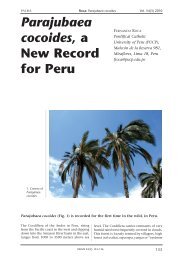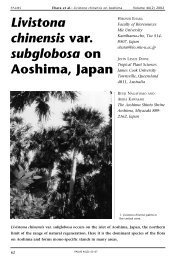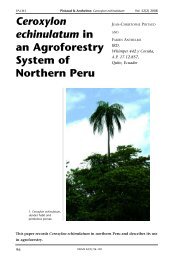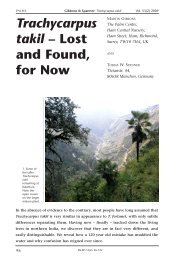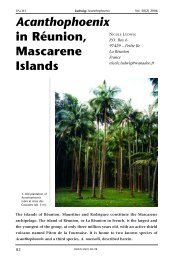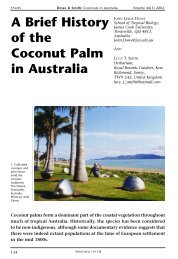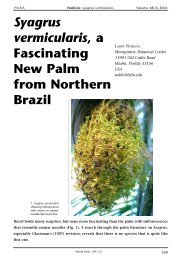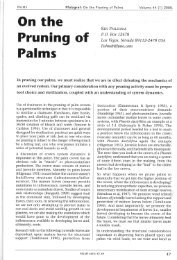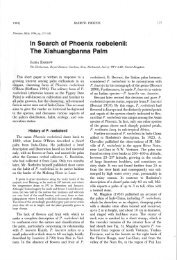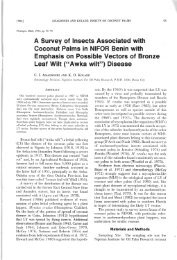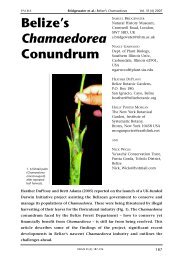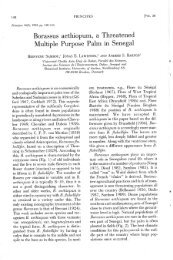Tahina – A New Palm Genus from Madagascar - International Palm ...
Tahina – A New Palm Genus from Madagascar - International Palm ...
Tahina – A New Palm Genus from Madagascar - International Palm ...
You also want an ePaper? Increase the reach of your titles
YUMPU automatically turns print PDFs into web optimized ePapers that Google loves.
PALMS Dransfield et al.: <strong>Tahina</strong> Vol. 52(1) 2008<br />
<strong>Tahina</strong> <strong>–</strong> A<br />
<strong>New</strong> <strong>Palm</strong><br />
<strong>Genus</strong> <strong>from</strong><br />
<strong>Madagascar</strong><br />
JOHN DRANSFIELD<br />
Herbarium, Royal Botanic<br />
Gardens, Kew, Richmond,<br />
Surrey, TW9 3AE, UK<br />
BRUNO LEROY<br />
c/o Mme Helimino,<br />
Société Fraise,<br />
BP 28 Antananarivo,<br />
<strong>Madagascar</strong><br />
XAVIER METZ<br />
VERAMA Cashew<br />
Estate/Groupe UNIMA,<br />
BP93-401 Mahajanga,<br />
<strong>Madagascar</strong><br />
AND<br />
MIJORO RAKOTOARINIVO<br />
Kew House, Lot 11J 131 B,<br />
Ambodivoanjo, Ivandry,<br />
Antananarivo, <strong>Madagascar</strong><br />
<strong>Tahina</strong>, the most massive fan palm in <strong>Madagascar</strong>, has recently been described<br />
and named as a new genus with the single species, T. spectabilis (Fig. 1). The story<br />
of its discovery follows.<br />
PALMS 52(1): 31<strong>–</strong>39<br />
1. Soejatmi Dransfield<br />
provides scale for the<br />
flowering individual of<br />
<strong>Tahina</strong> spectabilis.<br />
31
PALMS Dransfield et al.: <strong>Tahina</strong> Vol. 52(1) 2008<br />
The first intimation that there was a new and<br />
quite extraordinary palm in northwest<br />
<strong>Madagascar</strong> reached members of the<br />
<strong>International</strong> <strong>Palm</strong> Society in December 2006,<br />
when pictures of a strange fan palm were<br />
posted on the IPS Bulletin Board, <strong>Palm</strong>Talk.<br />
The discovery<br />
The discovery of a new palm genus in northwestern<br />
<strong>Madagascar</strong> has come as a complete<br />
surprise. The area where this palm was found<br />
is a very remote part of north-western<br />
<strong>Madagascar</strong>, northeast of the port of<br />
Mahajanga. The area is very difficult to access<br />
by land. It would take at least three days <strong>from</strong><br />
Mahajanga by four-wheel drive during the dry<br />
season. During the wet season would probably<br />
be next to impossible. The human population<br />
in the area is very sparse for <strong>Madagascar</strong>, with<br />
a thin scattering of villages.<br />
In the area are three fly-in beach resorts and a<br />
prawn hatchery. The prawn hatchery and<br />
rearing ponds produce <strong>Madagascar</strong> Tiger<br />
Prawns that are shipped out on a regular basis<br />
to supply the supermarkets of Europe. The tiger<br />
prawn company, UNIMA, has recently<br />
established a cashew nut plantation in the area<br />
as a method of re-forestation with the potential<br />
to play a significant role in carbon-trading, as<br />
well as providing a high quality cash crop. The<br />
manager of the plantation is Xavier Metz, a<br />
Frenchman born in <strong>Madagascar</strong>, who lives on<br />
the plantation in a house perched on the cliff<br />
overlooking the Mozambique Channel,<br />
together with his wife, Nathalie, and<br />
daughters, Marie-Nirina, Anne-<strong>Tahina</strong> and Léa-<br />
Mirana. In this remote part of <strong>Madagascar</strong>,<br />
opportunities for weekend family outings<br />
consist of boat trips and picnics on land. In<br />
2005 on one such family outing, the Metz<br />
family came across a low limestone hill to the<br />
northeast of the plantation where they saw<br />
interesting vegetation and old cliff graves. At<br />
the foot of the limestone hill they saw several<br />
huge palm trees. In the absence of flowers or<br />
fruit they assumed this to be a palm called<br />
locally dimaka (Borassus madagascariensis, a<br />
palm restricted to the west of the island where<br />
it is never very common) .<br />
In September 2006 they revisited the hill and<br />
were astonished to see one of the palms in<br />
spectacular flower, with the flowers being<br />
borne in a huge pyramidal bunch above the<br />
leaves of the palm. The Metz family had never<br />
seen anything like it, so they photographed it.<br />
Later that year, Xavier Metz met an old friend<br />
32<br />
of his, Bruno Leroy, in the <strong>Madagascar</strong> capital,<br />
Antananarivo. Bruno is a palm enthusiast.<br />
Xavier shared his photographs with Bruno and<br />
neither of them could say what it was. Bruno<br />
posted the pictures on the interactive bulletin<br />
board, <strong>Palm</strong>Talk, of the <strong>International</strong> <strong>Palm</strong><br />
Society (www.palms.org) on 6 December 2006.<br />
Within 24 hours there was already a rapidly<br />
developing discussion on what the spectacular<br />
palm might be. Several people suggested it was<br />
Borassus, or even Bismarckia (both native fan<br />
palms in <strong>Madagascar</strong>) while others pointed<br />
out that the flowers were completely wrong<br />
and resembled the Asian genus Corypha, the<br />
Talipot palm. On 7 December, Matt Patricelli<br />
of San Diego, a frequent contributor to the<br />
message board, alerted John Dransfield, to the<br />
mystery palm. John looked at the images,<br />
amazed. The palm looked incredibly like<br />
Asiatic Corypha <strong>from</strong> a distance. Could the<br />
palm have been introduced? However, the<br />
palm was unlikely to be planted as it occurs so<br />
far <strong>from</strong> anywhere and it was growing<br />
apparently on inhospitable karst limestone.<br />
Unfortunately details on the pictures were at<br />
too low a resolution to allow proper diagnosis.<br />
John posted his comments and also contacted<br />
Bruno directly. In January 2007, Bruno emailed<br />
a Google Earth reference point for the locality<br />
and amazingly palm crowns are actually visible<br />
in Google Earth, so enormous is the palm. It<br />
is also fortunate that there is relatively good<br />
resolution in Google Earth for this bit of<br />
<strong>Madagascar</strong>.<br />
John made arrangements with Bruno for his<br />
PhD student Mijoro Rakotoarinivo, to go in<br />
January 2007 to see the palm and to make<br />
scientific collections. Mijoro was successful<br />
and took further photographs, emailed to Kew,<br />
in which the palm looked significantly<br />
different <strong>from</strong> Asiatic Corypha.<br />
The mystery palm has a massive trunk to 18<br />
m tall with huge fan leaves up to 5 m in<br />
diameter, making it the biggest fan palm in<br />
<strong>Madagascar</strong>. John made a preliminary<br />
conclusion that the palm was almost certainly<br />
not only a new species but probably also<br />
belonged to a new genus. He then had to wait<br />
impatiently until the material of the palm<br />
reached Kew. At the same time, John and his<br />
co-authors, were putting the final touches to<br />
the manuscript of the second edition of Genera<br />
<strong>Palm</strong>arum, with the plan to hand in the<br />
manuscript to the publisher at the end of<br />
March 2007.
PALMS Dransfield et al.: <strong>Tahina</strong> Vol. 52(1) 2008<br />
Meanwhile, Mijoro arrived in Kew to continue<br />
his work for his PhD, and then at the end of<br />
March, the material of the mystery palm<br />
finally reached Kew. John and Mijoro opened<br />
the parcels of material, once they had passed<br />
through the Herbarium quarantine process of<br />
freezing, and it was immediately obvious that<br />
the palm was not Corypha nor was it even<br />
related to Corypha, but instead had features<br />
clearly showing it to be a new genus, and<br />
suggesting a relationship with the tribe<br />
Chuniophoeniceae that includes three other<br />
genera <strong>–</strong> Chuniophoenix in China and Vietnam,<br />
Kerriodoxa in southern Thailand and<br />
Nannorrhops in Arabia, Afghanistan and<br />
Pakistan.<br />
Faced with this, John had to down tools and<br />
immediately draw up a description of the new<br />
genus, even though this would have to be<br />
based on incomplete material (mummified<br />
flowers and ripe fruit) and then incorporate<br />
the description in the manuscript of Genera<br />
<strong>Palm</strong>arum. This involved a great deal of<br />
renumbering and changing of cross references.<br />
Kew artist Lucy Smith prepared analytical<br />
drawings to go with the description. Finally the<br />
manuscript of Genera <strong>Palm</strong>arum was ready for<br />
the publisher, about one month late.<br />
At the same time leaf material was sent off to<br />
colleagues Jack Fisher and Jay Horn in Fairchild<br />
Tropical Botanic Garden in Miami for<br />
anatomical study and further leaf samples were<br />
handed over to the Jodrell Laboratory in Kew<br />
for analysis of DNA by Ross Bayton. Ross’s<br />
molecular analysis confirmed the position of<br />
the genus in tribe Chuniophoeniceae of<br />
subfamily Coryphoideae. This palm group has<br />
a highly paradoxical distribution pattern, very<br />
difficult to understand, but morphology and<br />
DNA are unequivocal <strong>–</strong> the new genus has to<br />
belong to this group.<br />
How could such a spectacular and enormous<br />
palm have been missed in previous surveys,<br />
despite the great deal of attention given to the<br />
palms of <strong>Madagascar</strong>? The answer must be that<br />
the palm grows in an extremely remote part<br />
of <strong>Madagascar</strong>, an area which is otherwise very<br />
species poor in palms, and if the palm had<br />
been seen and not in flower it would probably<br />
have been overlooked as Borassus or Bismarckia.<br />
In June 2007, another individual of the palm<br />
showed signs of coming into flower <strong>–</strong> a giant<br />
asparagus-like shoot appeared above the leaves.<br />
Xavier Metz followed the development of the<br />
palm over the next few months, once the<br />
2. Anne-<strong>Tahina</strong> Metz, for whom the palm is named,<br />
standing at the foot of a tall individual of <strong>Tahina</strong><br />
spectabilis.<br />
flower-bearing branches had emerged,<br />
collecting small samples into alcohol and<br />
photographing progress. As the huge<br />
compound inflorescence began to develop, it<br />
looked increasingly likely to be in flower in<br />
September, just when John Dransfield planned<br />
to visit <strong>Madagascar</strong>, to supervise Mijoro’s<br />
research. John and Mijoro thus planned to<br />
spend a few days at end of the trip to see the<br />
new palm.<br />
In the meantime a full description of the palm<br />
was submitted to the Botanical Journal of the<br />
Linnean Society, naming the palm <strong>Tahina</strong><br />
spectabilis. <strong>Tahina</strong> in Malagasy means blessed<br />
or to be protected, and is part of the given<br />
name of the Metz’s second daughter, Anne-<br />
<strong>Tahina</strong> Metz (Fig. 2). The name has local<br />
meaning rather than being an unpronounceable<br />
Greek or Latin-based name of no<br />
obvious meaning to local people. The paper<br />
was finally published on 17 January 2008<br />
(Dransfield et al. 2008).<br />
In mid September, John and his wife, Soejatmi,<br />
and Mijoro visited the cashew plantation and<br />
33
PALMS Dransfield et al.: <strong>Tahina</strong> Vol. 52(1) 2008<br />
3 (top). View over the dry rice field to the tsingy and the flowering individual of <strong>Tahina</strong> spectabilis. The close<br />
proximity of the inflorescence to the limestone hill made sampling of the flowers unusually easy for such a<br />
big palm. 4 (bottom) The crown of <strong>Tahina</strong> spectabilis showing the deep triangular cleft at the base of the<br />
petiole.<br />
34
PALMS Dransfield et al.: <strong>Tahina</strong> Vol. 52(1) 2008<br />
5. The leaf of <strong>Tahina</strong> spectabilis viewed <strong>from</strong> beneath showing the major and minor folds.<br />
stayed with the Metz family. The flowering<br />
individual of the palm was about six days away<br />
<strong>from</strong> flower opening so they just missed the<br />
event. Nevertheless they were able to collect<br />
more material and made copious notes on the<br />
population (Figs. 3 & 4). They had extensive<br />
discussions with the Metz family and met<br />
people <strong>from</strong> the nearby village. The major<br />
topic of discussion was how to conserve the<br />
palm population for the future and how to<br />
harvest and distribute seed fairly worldwide<br />
without damaging the wild population but at<br />
the same time providing potential income to<br />
the village to act as an incentive to the<br />
conservation of the palm.<br />
Six days after they left the palm came into full<br />
flower, producing vast quantities of nectar that<br />
dripped off the flowering branches. Bees and<br />
wasps circled the inflorescence in huge<br />
numbers, and the Greater Vasa Parrot did some<br />
35
PALMS Dransfield et al.: <strong>Tahina</strong> Vol. 52(1) 2008<br />
damage, ripping off flowering branches to get<br />
at the nectar. Xavier and Nathalie continued<br />
to make observations and collect further<br />
samples of the flowers. Their close observations<br />
have added greatly to our understanding of<br />
the morphology of the palm. We now know<br />
that each bract on the flowering branches of<br />
the inflorescence (rachillae) has the potential<br />
to produce three flowers, although towards<br />
the tips of the rachillae only two or even one<br />
flower is produced. Flower opening seems to<br />
come in three waves, each one with massive<br />
production of nectar. It also seems that<br />
fertilisation is sporadic and the resulting fruit<br />
may originate <strong>from</strong> any of the three waves of<br />
flowering. Fruit seems to take about three to<br />
three and a half months to reach maturity.<br />
When the palm was in flower in September the<br />
flat land surrounding the limestone hill was<br />
bone dry and the soil surface cracked. By the<br />
end of December most of this land was under<br />
water, including the base of the palms at the<br />
foot of the limestone hill. Much of this<br />
seasonally flooded flat land was cleared long<br />
ago for rice cultivation and any semi-natural<br />
vegetation survives only at the foot of the<br />
limestone hill.<br />
The <strong>Palm</strong><br />
<strong>Tahina</strong> spectabilis is a solitary massive<br />
hapaxanthic hermaphroditic fan palm. The<br />
stem reaches about18 m tall and is about 50<br />
cm in diameter at breast height, with<br />
internodes 8<strong>–</strong>10 cm long, the nodal scars<br />
conspicuous. There are about 12<strong>–</strong>18 huge<br />
leaves in the crown; they are induplicate,<br />
costapalmate, and marcescent in immature<br />
individuals, tending to fall under their own<br />
weight in trunked individuals. The leaf sheath<br />
is about 80<strong>–</strong>100 × 52<strong>–</strong>58 cm and has a<br />
conspicuous triangular cleft below the petiole,<br />
with the margins tending to erode into broad<br />
tattered lobes. The petiole is massive, about 5<br />
m long in juvenile palms, but shorter in adults<br />
and is covered with white wax; it is 10<strong>–</strong>12 cm<br />
wide near the base and is deeply grooved on<br />
the upper surface and rounded beneath, and<br />
has smooth margins, completely lacking in<br />
spines. At the tip of the petiole is a well<br />
developed triangular hastula on the upper<br />
surface and a low ridge-like hastula on the<br />
undersurface. The costapalmate leaf blade is<br />
approximately 3.5<strong>–</strong>5 m in diameter in well<br />
grown adult palms, but in exposed individuals<br />
and juveniles it is much less; the blade is<br />
divided to ca. 1/2 its radius into multi-fold<br />
segments, these in turn more shallowly divided<br />
36<br />
6. Close up of a rachilla of <strong>Tahina</strong> spectabilis with<br />
flower buds.<br />
into a total of 110<strong>–</strong>122 single-fold segments,<br />
themselves shallowly divided along the abaxial<br />
folds, the blade between each fold being up to<br />
10 cm wide; the main abaxial (lower) ribs of<br />
the blade are very conspicuous, very crowded<br />
at the base of the blade, with some much more<br />
robust than others, the less robust ribs tending<br />
to be inserted in a more adaxial (upper)<br />
position compared with the robust ribs <strong>–</strong> this<br />
curious arrangement of folds seems to be<br />
unique to this genus and would be a very<br />
useful character for distinguishing the palm<br />
when sterile (Fig. 5). There are abundant<br />
transverse veinlets between the main ribs. The<br />
whole leaf texture is surprisingly thin when<br />
compared with that of Bismarckia or Borassus.<br />
The inflorescence is held above the leaves and
PALMS Dransfield et al.: <strong>Tahina</strong> Vol. 52(1) 2008<br />
is a huge compound structure to 6 m tall,<br />
composed of numerous (to ca. 45) lateral<br />
inflorescences, each branched to 3 orders, all<br />
branches ending in rachillae. The tubular<br />
inflorescence bracts are conspicuous<br />
throughout, and are generally covered in thick<br />
white indumentums. The rigid rachillae are<br />
10<strong>–</strong>15 cm long and ca. 0.5 cm in diameter and<br />
are covered with conspicuous chestnut brown<br />
bracts that subtend the flower clusters (Fig. 6).<br />
the flower clusters consist of up to three<br />
flowers with their attendant bracteoles. The<br />
flowers are hermaphroditic, approximately 8<br />
× 2.5 mm in bud and are exerted <strong>from</strong> the<br />
rachilla bracts. Flower opening (anthesis)<br />
seems to proceed in up to three waves, as the<br />
flowers of the flower cluster reach maturity<br />
sequentially. The thin membranous calyx is<br />
tubular with three rounded lobes and splits<br />
irregularly. The corolla has a basal solid stalk<br />
and three green lobes that become strongly<br />
reflexed when the flower opens, with the base<br />
of the lobes appearing to be nectar producing.<br />
The stamens are 6 in number and have free<br />
rod-like filaments and bright yellow anthers<br />
attached at their middles and versatile on the<br />
filaments. The gynoecium consists of three<br />
completely fused carpels, each with an<br />
anatropous basally attached ovule, and a<br />
common style ending in three minutely divide<br />
stigmas that appear not to reflex at anthesis.<br />
The fruit is green at maturity and is broadly<br />
ellipsoid to obovoid, 25<strong>–</strong>30 × 20<strong>–</strong>22 mm, borne<br />
on the stalk-like corolla base, 5<strong>–</strong>7 × 2 mm.<br />
Each fruit contains a single seed and has apical<br />
stigmatic remains; the epicarp is smooth and<br />
glabrous, the mesocarp is moderately thick,<br />
spongy, with few longitudinal fibers and the<br />
endocarp thin, 13<strong>–</strong>17 × 17<strong>–</strong>22 mm,<br />
crustaceous, with a pronounced longitudinal<br />
groove and a short apical beak, and irregularly<br />
anastomosing grooves. The seed is globose,<br />
1.8<strong>–</strong>2.2 × 1.4<strong>–</strong>1.8 cm, laterally attached with an<br />
elongate hilum, and with deep grooves<br />
corresponding to the rapheal bundles; the<br />
endosperm is strongly ruminate, without a<br />
central hollow and the embryo is sub-basal.<br />
Germination is remote-ligular with a palmate<br />
eophyll.<br />
The population<br />
7. Three massive individuals of <strong>Tahina</strong> spectabilis at the foot of the limestone hill.<br />
During a complete census of the palm in<br />
September 2007, Xavier Metz counted 92<br />
individuals, of very mixed ages, <strong>from</strong> small<br />
rosette palms to huge non-flowering adults.<br />
As well as these established plants, there are<br />
several hundred one or two-leaved seedlings<br />
resulting <strong>from</strong> the 2006 flowering event. As<br />
far as can be seen, these seedlings are restricted<br />
to the base of dead trunk and to areas perhaps<br />
a few meters away. All the palms are restricted<br />
to the northern end of the narrow north-south<br />
37
DRANSFIELD ET AL.<br />
PALMS Dransfield et al.: <strong>Tahina</strong> Vol. 52(1) 2008<br />
4. Actual and predicted occurrences of <strong>Tahina</strong> spectabilis.<br />
8. Using ecological parameters the possible potential<br />
distribution of <strong>Tahina</strong> spectabilis can be calculated<br />
using the GIS program MAXENT. The red marked<br />
areas are areas where the palm should be sought.<br />
outh and about 250 m long, carrying a semivegetation<br />
(Fig. 3A). The outcrop is visible in<br />
imagery at Google Earth and the grey crowns<br />
alm are even visible, although blurred.<br />
orientated limestone hill (Fig. 7), except for a<br />
single individual <strong>–</strong> a well established juvenile<br />
palm with a very short trunk, which occurs<br />
about 0.5 km away <strong>from</strong> the limestone hill at<br />
the edge of the nearby village and at the edge<br />
of the seasonally flooded flat lands.<br />
: Although the annual precipitation is estio<br />
be about 1600 mm, the climate of this locallassed<br />
as dry and warm. Drought is manifest<br />
of the eight dry months, the mean annual<br />
ature around 27 °C, and the very strong insothroughout<br />
the year (source: Bioclim, 2006;<br />
ww.bioclim.org). Moreover, the high permeof<br />
the limestone may also decrease the moise<br />
during the warmest period of the day. At the<br />
me, edaphic conditions The Habitat<br />
in the tsingy are harsh;<br />
rcely exists in many places, and leaf litter is<br />
thin and poorly decomposed. The vegetation is<br />
oodland dominated by xerophytes and succuuch<br />
as species of Euphorbia, Aloe, and Kalanbout<br />
90 individuals were seen, most of them<br />
on the sandstone plain at the edge of the<br />
and a single, short individual was also found<br />
e village of Antsanifera. The sandstone plain is<br />
When news first came through about the<br />
palm, we assumed that it grew on limestone.<br />
This is, however, not the case. All individuals<br />
grow in deep soil at the very foot of the<br />
limestone. This habitat is dry during the dry<br />
season but may be flooded up to 50 cm deep<br />
with freshwater during the rainy season. The<br />
palms thus grow with their feet in water during<br />
this wet period. That they should be confined<br />
to the very foot of the limestone hill is perhaps<br />
a reflection of the fact that this part of the<br />
seasonal swamp is not under rice cultivation<br />
and is also hardly affected by seasonal fires <strong>–</strong><br />
the limestone protects the palm in the narrow<br />
areas between the outcrops. As mentioned<br />
above, there is one individual growing about<br />
a half kilometer away <strong>from</strong> the limestone hill<br />
at the edge of a nearby village, at the edge of<br />
the seasonally flooded area, adding evidence<br />
that the palm is perhaps only secondarily<br />
associated with limestone.<br />
We speculate that the palm was perhaps a<br />
dominant plant of seasonally flooded wetlands<br />
38<br />
covered by herbaceous savannah with abundant individuals<br />
of the palm Hyphaene coriacea, and environmental<br />
conditions are totally different. The humidity<br />
rate is much higher as water stagnates during the<br />
humid season. Individuals of T. spectabilis on these<br />
flats are robust and often occur in groups of two to<br />
five trunks. The individual sampled was on this plain.<br />
Analysis of the potential distribution of T. spectabilis<br />
using Maxent 2.2 identified only the coastal region<br />
of the north-west, between Analalava and Mitsinjo<br />
(Fig. 4), as a suitable habitat. This small predicted<br />
area can primarily be explained by the high sensibility<br />
of this palm to temperature variations during the<br />
coldest and driest season (June<strong>–</strong>September) as well as<br />
the geology type (Fig. 4; training gain, 2.7<strong>–</strong>3.2). The<br />
coastal region in which the palm is found is always<br />
much warmer than the adjacent inland area. Temperatures<br />
between June and September in the coastal<br />
region do not fall below a mean of 25 °C and a<br />
minimum of 19 °C, whereas those inland may decrease<br />
to 22 and 16 °C, respectively. These temperature differences<br />
over a small distance seem to be critical, and<br />
may inhibit the colonization of new areas.<br />
© 2008 The Linnean Society of London, Botanical Journal of the Linnean Society, 2008, 156, 79<strong>–</strong>91<br />
in this area and now survives only where it has<br />
some protection <strong>from</strong> fire. One can imagine<br />
how spectacular a swamp filled with gigantic<br />
palm may have been before the arrival of man.<br />
Are there likely to be any other populations of<br />
the palm? Given that this population has only<br />
just been discovered, it seems not impossible<br />
that there may be other populations. Mijoro<br />
carried out a prediction based on the ecological<br />
parameters of the site as we know them and<br />
concluded that there is a limited predicted<br />
distribution as shown in Fig. 8. Unfortunately,<br />
most of the predicted areas have rather poor<br />
resolution in Google Earth so the prospect of<br />
scanning through image after image to look for<br />
the distinctive gray-green crowns and finding<br />
anything seems unlikely. Furthermore blue<br />
green Bismarckias are abundant throughout<br />
the predicted range and could easily be<br />
confused with <strong>Tahina</strong> in satellite imagery. We<br />
suggest that the palm is almost certainly a great<br />
rarity.<br />
What we know of its natural history<br />
None of the villagers has any recollection of<br />
the palm ever flowering before 2006 when the<br />
first individual flowered. It is very difficult to<br />
imagine that the villagers who live so near to<br />
the limestone would miss such a spectacular<br />
event as the palm producing the giant<br />
compound inflorescence. Furthermore there<br />
are no signs of dead trees with decaying<br />
inflorescences apart <strong>from</strong> the tree that flowered<br />
in 2006. This all seems to suggest that<br />
flowering has been a very rare event. Thus we<br />
have absolutely no idea how long it takes for<br />
a seedling to grow to adulthood and flowering<br />
and we cannot estimate how old the<br />
magnificent trees that tower over the nearby<br />
juveniles are.<br />
As mentioned above it seems to take about<br />
three months <strong>from</strong> the first appearance of the<br />
inflorescence to full expansion of the rachillae<br />
and flower opening and a further three to three<br />
and a half months for fruit to reach maturity.<br />
With up to three flowers per rachilla bract<br />
produced sequentially there are three waves<br />
of flower opening. Throughout flower opening<br />
there is production of copious nectar,<br />
apparently <strong>from</strong> the petal bases. This attracts<br />
large numbers of bees, wasps and flies, and<br />
also parrots.<br />
The Future<br />
The key to the survival of <strong>Tahina</strong> spectabilis in<br />
its natural habitat lies with the villagers who
PALMS Dransfield et al.: <strong>Tahina</strong> Vol. 52(1) 2008<br />
live nearby. Under current Malagasy<br />
Government legislation the people of the two<br />
villages nearby have control over the<br />
exploitation of the natural resources under<br />
COBA. This legislation empowers the villagers<br />
to make decisions affecting the survival of local<br />
biodiversity. To us, the best way of ensuring<br />
that the villagers protect the palm is if they<br />
understand that there is benefit to be had <strong>from</strong><br />
maintaining the palm population in good<br />
health. Unfortunately, the locality is so far off<br />
the beaten track that it is very unlikely that a<br />
significant number of tourists will visit to view<br />
the palm, so the potential for income <strong>from</strong><br />
tourism seems negligible. On the other hand,<br />
palm enthusiasts world wide are highly likely<br />
to want to grow the palm. Even if it may take<br />
decades to reach flowering size, and even if<br />
most amateur growers are unlikely to have the<br />
space to grow the palm in the ground, there<br />
is no doubting the appeal of the palm,<br />
especially as seedlings and young juveniles. In<br />
order to satisfy this potential demand, we have<br />
proposed a controlled harvest of seed <strong>from</strong> the<br />
individual that flowered in 2007. A substantial<br />
number of seeds will be allowed to fend for<br />
themselves without human intervention. A<br />
further proportion will be sown on site, and<br />
further seeds grown in a nursery at the cashew<br />
plantation, with progeny being plated on site<br />
where suitable. A proportion of seed will be<br />
distributed to botanic gardens and arboreta<br />
within <strong>Madagascar</strong> and, finally, seed will be<br />
harvested specifically for distribution overseas,<br />
gratis to suitable botanic gardens, and the rest<br />
sold with a significant proportion of the profit<br />
being returned to the village committee to be<br />
used for village development (such as<br />
improvements to the water supply). It is hoped<br />
in this way the village will appreciated the<br />
benefit of the palm and that this will provide<br />
an incentive to protect it.<br />
Already to this end the villagers have set up a<br />
parrot patrol to scare away the birds <strong>from</strong> the<br />
palm and prevent damage to the flowers and<br />
developing fruit. The palms have now been<br />
fenced by the villagers to prevent zebu cattle<br />
<strong>from</strong> damaging the young plants of the palm.<br />
A village committee has been set up to take<br />
control of the conservation of the palm and<br />
conspicuous signs placed outside the fenced<br />
area prohibiting access.<br />
Acknowledgments<br />
Field work in <strong>Madagascar</strong> was supported by<br />
the Foundation and Friends of the Royal<br />
Botanic Gardens Kew through its Threatened<br />
Plants Appeal Project. Special thanks to<br />
Nathalie, Marie-Nirina, Anne-<strong>Tahina</strong> and Léa-<br />
Mirana Metz and members of the local<br />
community of the GCF ‘VITAZARA’<br />
represented by M. Zaramanana (President of<br />
GCF, President of Fokontany Antsanifera) and<br />
the traditional leaders MM. Madiomanana,<br />
Leratsy and Soavelo. We thank VERAMA<br />
Cashew Estate of GROUPE UNIMA, especially<br />
Chairman Aziz Hassam Ismail and Chief<br />
Executive Officer Amyne Hassam Ismail and<br />
their staff. Antoine Leveau, head of VERAMA<br />
R&D department helped in preparation of<br />
photos and in making samples.<br />
LITERATURE CITED<br />
DRANSFIELD, J., M. RAKOTOARINIVO, W.J. BAKER,<br />
R.P. BAYTON, J.B. FISHER, J.W. HORN, B. LEROY<br />
AND X. METZ. 2008. A new Coryphoid palm<br />
genus <strong>from</strong> <strong>Madagascar</strong>. Bot. J. Linn. Soc.<br />
156: 79<strong>–</strong>91.<br />
39



